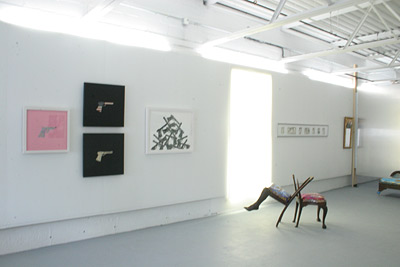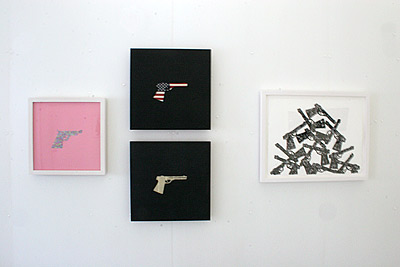<< home
<< phoenix
 |
Give it some gas: Zero Station + political action Gilles Deleuze and Félix Guattari posit a model of the modern individual as a schizophrenic Jekyll-and-Hyde born of nation-state control through the manufacture of desire and the free-market anarchy of capitalism rampantly commodifying all aspects of being. Not a pretty picture to be sure, so no wonder a continuous line of switched-on artists over the course of modern history would seek to deliver wake-up calls to the infantilized masses still locked into a delivered mode of perception. Enter the good folks at Zero Station who, tucked away in a converted gas station, have resolved to maintain a vigilant commitment to social change through the arts. The current group show, entitled "Take Me to Your Leader," is an aesthetically pleasing collection of photography, illustration, graphic design and "couch art" intended to raise questions concerning global politics and personal accountability. Is this didactic mind-expansion something the viewer desires from a piece of art? And if there is a good market for politicized art (pardon the commodification), then what distinguishes the effectiveness of an approach? The signs of "handgun" and "flag" are hurled at one another by the artist, to solicit within the viewer questions and connections regarding their interwoven signification. Lucy White provides a series of firearm-themed images that provide an example of this variance. Two handsome pieces encased in black resin portray silhouettes of a handgun. Revealed in the positive space of one gun is the image of an American flag and, in the other, NASDAQ stock listings. Both pieces play into a simple tactic of juxtaposition. The signs of "handgun" and "flag" are hurled at one another by the artist, to solicit within the viewer questions and connections regarding their interwoven signification. Whether this dualistic approach really works may depend on whether you're talking to Dr. Jekyll or Mr. Hyde. After all, we are constantly bombarded with messages inciting action so that the AIDS crisis in Africa can be addressed, health care can be provided for all Americans, and conflict resolved in the Middle East. We must cope with the cognitive dissonance of these problems within the parameters of our daily life. The result is, pessimistically, schizophrenic grumbling over the price of gas while filling up for the commute home in time to catch the evening news. White exemplifies another method with "GUN PILE," formulated by painted images of the gun silhouette haphazardly piled on top of one another in a somewhat fractal manner. Rather than juxtaposing two intellectual concepts, White deterritorializes the signifiers and constructs an entirely new piece as an ordered cosmos with its own beautiful validity.
... For Deleuze, the standard of achievement (regarding whatever state of affairs a politicized artistic practice seeks to rectify) is "immanence," an internal realization of one's own potential outside of pre-established and judged norms. He states, "Herein, perhaps, lies the secret: to bring into existence and not to judge. If it is so disgusting to judge, it is not because everything is of equal value, but on the contrary because what has value can be made or distinguished only by defying judgment. What expert judgment, in art, could ever bear on the work to come?" At the risk of judgment, perhaps the best political art is that which inspires creative action by the perceiver. It may seem antithetical that a gallery dealing in commodities could lead the way for a local increase in creative action and awareness, but Zero Station makes clear its intentions to earnestly grapple with this paradox. The more the viewer/consumer is incited to become creator, the closer we become to harmonious interrelationships where politics are nullified. Copyright © 2006 The Phoenix Media/Communications Group |
